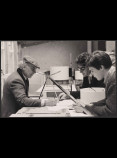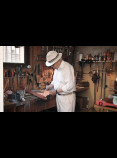Occupation as profession


Miguel Milá al taller. Fotografia: Poldo Pomés
‘If I could solve a design without the complication of moulds, so much the better. A mould is ultimately a form of slavery. Plus, industry doesn’t always solve econòmic problems.’
Parallel to his architectural learning associated with a certain aesthetic view of shapes, volumes and materials, Miguel Milá also developed solid technical and mechanical skills alongside woodworking and blacksmithing craftsmen. In addition to Cintet, his family’s carpenter, he also enlisted the skills of the blacksmith Cutié when designing the TN lamp: ‘We would spend the afternoon filing and talking, and that’s how I learned so much from him’.
His fondness of this artisan phase of the process is one of Milá’s hallmarks. The workshop has roots in a humanistic vocation sensitive to the dignity of work that creates, modifies, shapes, recrafts and finishes, always aware of the match between purposes and means, and subject to an inevitable economy of resources.
‘The ultimate purpose of my defence of craftsmanship and the entire artisan process in general at this time in which we live is to defend people's right to participate in the processes of things’.
The workshop is the site of the fullest participation in these processes, where the idea takes shape in close conjunction with materials and tools and their manipulation. Randomness, too, can also play an important role. One example is Cesta, a lamp that originated from finding an oval-shaped glass globe that the designer decided to attach to a little rattan basket made for that purpose. So, the taste for the workshop, the ‘tool shortage’ that Milá admits to, shaped the first technological link in the process and animated a propitiatory rite in which the idea gradually gels in the guise of a prototype.

